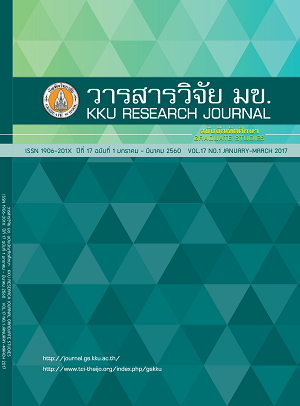Condensation of H2O2-H2O-Air Exhaust Gas Through Four In-Line Tube Bundles in a Heat Exchanger (การควบแน่นของก๊าซเสียที่ประกอบด้วย ไฮโดรเจนเปอร์ออกไซด์-น้ำ-อากาศ เมื่อไหลผ่านชุดแลกเปลี่ยนความร้อนที่ประกอบด้วย)
Keywords:
Condensation (การควบแน่น), Concentration (ความเข้มขัต), Heat transfer (การถ่ายเทความร้อน), Heat exchanger (ชุดแลกเปลี่ยนความร้อน), Hydrogen peroxide (ไฮโดรเจนเปอร์ออกไซด์)Abstract
This study was aimed to investigate the condensation of hydrogen peroxide vapor (H2O2) and water vapor (H2O) in exhaust gases, when flowing through a tube-type heat exchanger with four in-line tube bundles in a cross-flow direction. It was investigated from a test-rig and compared with the results from the computation model study in ANSYS Fluent software. The experimental results showed condensation rates inside the heat exchanger increased with the increase in the cold water flow rate, or decreased in the cooling water temperature. In addition, the maximum hydrogen peroxide concentration in the condensed liquid increased with increases in the cold water flow rate and temperature. These findings described herein, on the condensation of hydrogen peroxide resulted in decreasing concentration of hydrogen peroxide in exhaust gases. It may help to reduce the negatives impact on the environment and human health. It may also can reduce the cost in the aseptic food process.
การศึกษานี้มีวัตถุประสงค์เพื่อศึกษาการควบแน่นของไฮโดรเจนเปอร์ออกไซด์ (H2O2) และไอน้ำ (H2O) ในก๊าซเสียที่ไหลผ่านชุดแลกเปลี่ยนความร้อนแบบท่อซึ่งมีชุดท่อสี่ชุดจัดวางอยู่ในแนวเดียวกัน โดยได้ทำการทดสอบกับชุดทดลองและทำการเปรียบเทียบผลกับผลที่ได้จากการศึกษาแบบจำลองในโปรแกรม ANSYS Fluent ผลการทดลองแสดงให้เห็นว่า อัตราการควบแน่นภายในชุดแลกเปลี่ยนความร้อนเพิ่มขึ้นเมื่ออัตราการไหลของน้ำเย็นเพิ่มขึ้น หรือเมื่อลดอุณหภูมิของน้ำเย็นต่ำลง ความเข้มข้นของไฮโดรเจนเปอร์ออกไซด์ที่ได้จากการควบแน่นจะเพิ่มขึ้นเมื่ออัตราการไหลหรืออุณหภูมิของน้ำเย็นเพิ่มขึ้น การค้นพบนี้อธิบายได้ว่า การควบแน่นของไฮโดรเจนเปอร์ออกไซด์ทำให้ก๊าซเสียมีความเข้มข้นของไฮโดรเจนเปอร์ออกไซด์ลดลง ซึ่งสามารถลดผลกระทบต่อสิ่งแวดล้อมและสุขภาพของมนุษย์ อีกทั้งยังลดต้นทุนในการกระบวนการผลิตอาหารแบบปลอดเชื้อด้วย


